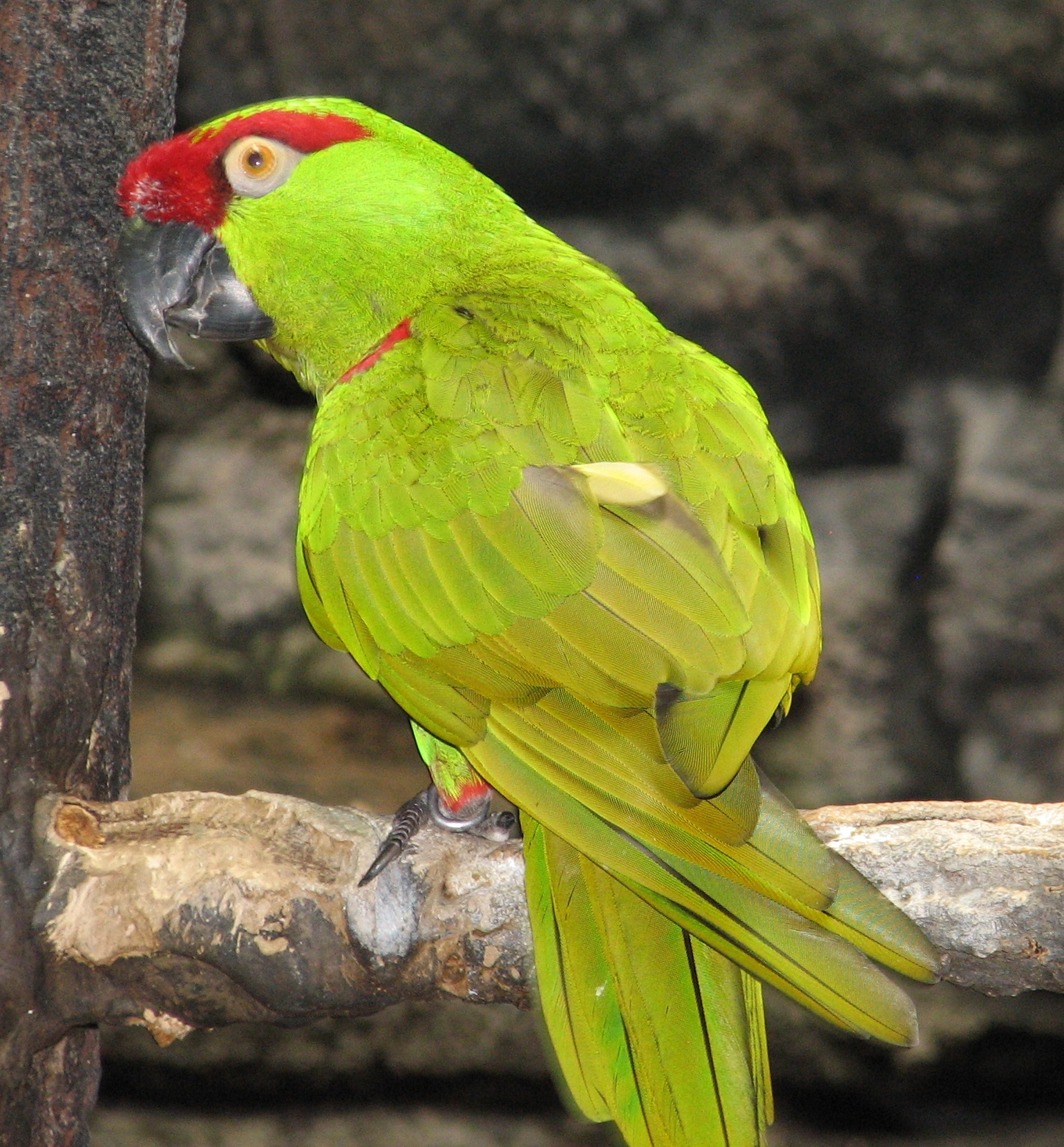- Thick-billed Parrot
Taxobox
name = Thick-Billed Parrot
status = EN | status_system = IUCN3.1

image_caption = At Cincinnati Zoo, USA
image_width = 225px
regnum =Animal ia
phylum = Chordata
classis = Aves
ordo =Psittaciformes
familia =Psittacidae
genus = "Rhynchopsitta "
species = "R. pachyrhyncha"
binomial = "Rhynchopsitta pachyrhyncha"
binomial_authority = Swainson,1827 The Thick-Billed Parrot, "Rhynchopsitta pachyrhyncha" is a medium-sized, up to 38cm long, bright greenparrot with a large black bill and a red forecrown, shoulder and thighs. Adult eyes are amber, while juveniles have brown eyes. The rest of the bird is bright green. Thick-billed Parrots show red shoulders and leading edge on the underwing, followed by a blackish green stripe, then a yellow stripe, followed by the remaining underwing showing dark green. It appears to show a blackish tail. The bird sounds like a high pitched macaw and makes a variety of harsh, rolling calls. They are adept fliers.The Thick-Billed Parrot lives in temperate conifer, pine, mature pine-oak and fir forests from 1200 to 3600 meters. For the most part, it is restricted to the
Sierra Madre Occidental ofMexico , though it used to live in the southwesternUnited States . Birds had been reintroduced inArizona in the early 1980s, but this effort turned out to be unsuccessful. The parrots could not adapt to avoiding natural predators. It likes to nest in tree cavities, especially oldwoodpecker holes. It principally feeds on seed from various pine species, so much so their entire lives revolve around cone production. Flocks of these parrots roost by cliffs and they breed at the peak of pine seed production. It is nomadic, following the variations of cone abundance.Habitat destruction and illegal bird trading gives the Thick-Billed Parrot itsEndangered status on theIUCN Red List of Threatened Species and listing on Appendix I ofCITES . It is estimated that only 1000-4000 Thick-billed Parrot exist. However, this last living parrot species native to the United States is well-established in captive breeding programs in manyzoos across the world.Arizona re-introduction
The re-introduction into the mountains of southeastern
Arizona -(theMadrean sky islands region of Arizona), though well planned was dramatically impacted by predation. Due to extensive human development, residency,agriculture , etc., high numbers of predator species exist, especiallyhawks , and especially thegoshawk . The bird loss was especially high to these now well-emplaced predator species. A future attempt at introduction would have to include an ecosystem area that somehow limits the success of the numerous predator species.pecies' conservation
For more than 10 years,
Pronatura Noreste (a northeastern Mexican environmental NGO) andMonterrey Institute of Technology and Higher Education have been monitoring 700 nests of Thick-Billed Parrots in Chihuahua. On the other hand, through conservation easements with theejido s, the organization has created ancient forest sanctuaries for the protection of the bird's habitat.References
* Database entry includes a range map, a brief justification of why this species is endangered, and the criteria used
* Howell, Steven N. G. & Webb, Sophie (1995): "A Guide to the Birds of Mexico and Northern Central America". Oxford University Press, Oxford & New York. ISBN 0-19-854012-4External links
* [http://uninet.mty.itesm.mx/1_8_1_1.htm ITESM Site]
* ARKive - [http://www.arkive.org/species/GES/birds/Rhynchopsitta_pachyrhyncha/ images and movies of the Thick-billed Parrot "(Rhynchopsitta pachyrhyncha)"]
* [http://www.birdlife.org/datazone/species/index.html?action=SpcHTMDetails.asp&sid=1584&m=0 BirdLife Species Factsheet]
* [http://www.redlist.org/search/details.php?species=19715 IUCN Red List]
* [http://www.pronaturane.org/eng/ecoregions/smoccidental.htm Pronatura Noreste in Sierra Madre Occidental]
* [http://www.bird-stamps.org/cspecies/7419800.htm Stamps] forMexico ,United States
* [http://ibc.hbw.com/ibc/phtml/especie.phtml?idEspecie=2247 Thick-billed Parrot videos] on the Internet Bird Collection
Wikimedia Foundation. 2010.
